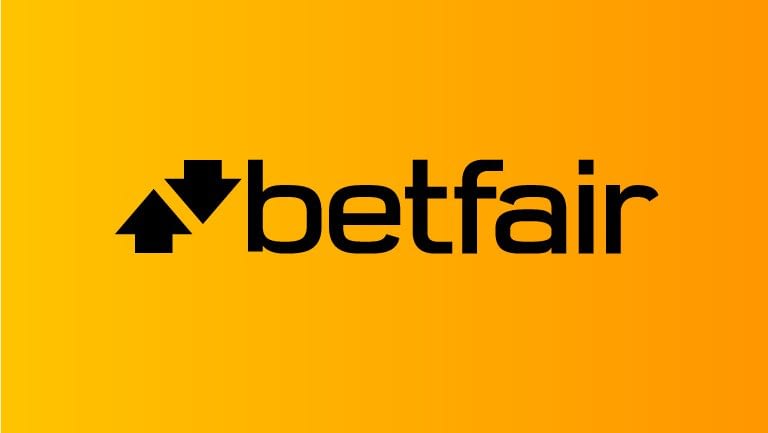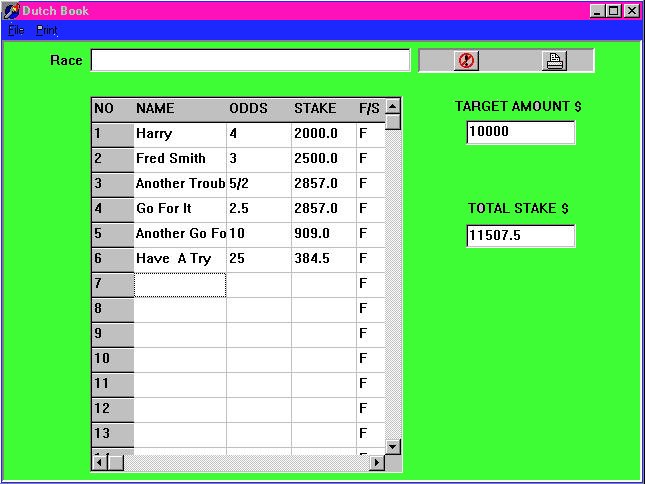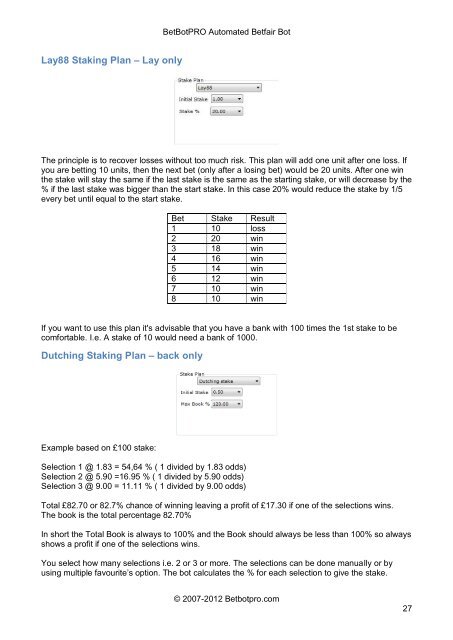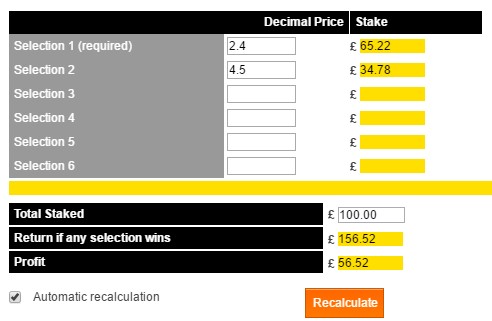Betfair Dutching
If you want to place Dutching bets on the selections you pick, go through the following steps: 1. Switch the market into Full Mode 2. Disable all selections first. Choose the ones you want to place Dutching bets on. Open the Dutching settings, configure the amount to. A short video showing how to place a Dutch bet directly onto the Betfair. The Betfair exchange has a useful option built in, allowing users to select multipl.
Dutching on horse racing
We have covered Dutching before in a number of articles, so read up on those specifics if you want to learn what Dutching is, how to do and how to use the specialist tools in Bet Angel to do perform a dutch bet.
Speaking broadly, Dutching is a viable betting strategy on the betting exchanges now as the book overround is so small. A Dutch bet covers a number of selections in a sports betting market, rather than just one. This will increase your chances because you will win if any of those selections win.
Bet Angel contains an advanced Dutching calculator. This means not only can you make multiple selections with your dutch bet, but you can also set a profit target, varying the profit not just the stake on each selection. But you can drive your risk and reward by varying the amount staked or the number of selections. So it makes for a good tool and strategy.
Betfair Dutching Software
In this article, we look specifically at a ‘hidden’ feature that will allow you to get more out of any dutching strategy you use.
If you can only back bets then where are there more columns?
Let me show you something. You’ll notice on the dutching screen written in big, bold letters is “Dutching places only BACK bets into the market.”
Betfair Dutching Bot
If we actually look in more detail at the dutching screen, the columns we have on this screen show back, lay and manual. So naturally the question of why we have a ‘lay’ column comes to if you can only place back bets into the market?
Well, the answer comes from the book percentage. In the previous example on the other article, we backed six selections for 66% of the book. We’re going to use a stake of £100 and you can see on the righthand side that our ‘predicted profit’ could return £49.
In comparison, we could say we want to return £100, so by changing the back stake for a target profit of £100 (shown in the top left box below), you can see it says we need a total stake of £200. So we would make £100 if any one of these six horses go on to win this race, by having a stake of £200 into the market.
If I back at the current lay price on these selections, you can see in the image below that our total stake goes down.
Our plan is to place back bets in the market, but we’re going to back at the current lay price. This doesn’t place a lay bet, it still places a back bet, but at the current lay price. The current lay price is usually one tick up at decimal odds, but each tick adds extra profit or reduces your stake when dutching.
Betting Dutching
Now, those are going to be unmatched bets and naturally you need those bets to get filled. There are a number of ways of doing that, but essentially what you’re doing is you’re getting a better value bet by backing at the current lay price and asking for a price within the market.
If we go to use manual, you could actually ask for another price that doesn’t exist at this particular moment, somewhere slightly further out from the money.
But by backing at the current lay price, you squeeze that little bit of extra margin out of the book, which will help you overcome the commission that you pay. I have hinted at this practice in the past, discussing ways that dutching can help you to overcome some of the commission issues and this is one way to do so.
By basically taking a chunk of the book and asking for the price within the market, you’re actually creating a little bit more value in it.
So that will come in two forms, firstly it will come in either a lower stake, if you’re backing for a fixed target profit. Then if we look at the back with a stake off, in other words, if we’re using a fixed stake rather than looking for a target profit then you’ll notice that the return that you get, the predicted profit column, that number goes up.
So whichever way you do it, you’re going to get slightly more money out of that particular position.
So why dutch?
Dutching is a good way of aggregating risk, but also achieving a better chance of a payoff, simply by offering bets to the market. Now, those will be unmatched bets when they reach the market, but you’ll find that overall that makes a huge difference because you a tiny edge here as you start to amplify over many, many markets which becomes a huge edge for you after thousands of markets!
Dutching is placing back bets into the market, but you can back at the current back price, you can back at the current lay price and you could back at prices that you nominate, that’s a good way of getting extra value from it.

But when you are dutching, you should think about how much of the field you cover. Are you covering just one little part of the field? Because then essentially your Dutch bet becomes an outright bet on that favourite or this small part of the field, it doesn’t deliver much value to you. You might as well just bet the favourite!


But obviously one of the great things about dutching is that you can actually back any one of ‘x’ number of runners. So here we’re expanding that list to quite a large number of runners and we’re giving ourself the capacity to be able to profit if any of those come in, which you can’t do on much smaller fields.
So there you go!
Betfair Dutching App
I hope that gave you a little further exploration into the dutching side of things. I hope that this has given you a bit of a grip on the sort of stuff that you can do and how you have use dutching.
The Concept
If you are not already familiar with the term Dutching the concept is very simple and its the process of betting on more than one selection or runner in a market to cover several outcomes and return an equal profit no matter which of them is the eventual winner.
The origin of this tactic is sketchy but often attributed to Arthur Flegenheimer, also known as Dutchy Schultz, in gangster circles, alongside various rackets he had running at the racetrack. The strategy has since taken his name.
What this Betfair trading strategy does is turn traditional betting on its head. When you place a traditional bet you are trying to find a winner, but with Dutching you are defining how much you want to win then making a range of selections that could win and you will an equal amount if any of those go on to win.
Betfair Dutching Calculator
Scenario’s
Imagine in horse racing your looking at a competitive handicap race with twenty-plus runners, all roughly similarly weighted and with many at the front of the betting all priced at similar odds. Trying to pick a winner is almost an impossible puzzle to solve from a betting perspective.
By Dutching you can simplify the problem, instead of worrying about picking a single runner to win, you can now say ‘I expect any one of these four, five or six selections to win’, making your task of profiting so much easier and far likelier than trying to find a winner by picking a single selection.
It is also a very popular method among Soccer traders with many opting to Dutch the correct score market for the same reasons as above it allows you to cover multiple selections or in this case score lines. For example, you may feel the away side will sneak a win but don’t have any idea what the actual score might be so may opt to cover a few and dutch the 0-1, 0-2 and 1-2 scores, this again increases the chances you winning as any of these scores will now return and equal profit. Much easier than trying to pick a specific score.
Bet Angel Dutching Calculator
The first thing you’re probably thinking now is that’s all fine and good but how do I work out what stakes to place so that I get an equal profit on the selections I choose and how long will this take?
Betfair Dutching Strategy
This is where Betfair software like Bet Angel will help. Bet Angel contains a Dutching bet calculator that is intuitive and easy to use. the process could not be made simpler, all you need do is set your stake then tick the selections/runners you wish to Dutch, you can take the current back price at the current available decimal odds or ask for your own price and wait to see if someone is willing to take it or do a mixture of both, then click ‘Place Bet’ and job done. Bet Angel will work out all the total stakes required for the prices asked for to return an equal profit on the selections chosen.
In the image below I’ve chosen to use a £100 stake and dutched the front 4 runners in this race taking the current back price for each. In the stake column (2nd from right) you can see the stakes which have been calculated by Bet Angel for each runner. If any of the 4 runners I have dutched win I will make a profit of £62.17
If none of the 4 runners win then I will lose my £100 stake, you can see this by looking at the figures in the predicted profit column.
Bet Angel’s Advanced Dutching
What I’ve covered here is just the bare basics of what’s possible with the Bet Angel Dutching tool. For starters, as you can see in the image there are three different staking methods to choose from and each of these open up additional options like the ability to set margin percentages on selection.

Or if you opt to dutch to a target potential profit it’s also possible to go even further and override the profits of individual selections, this is known as advanced Dutching or variable Dutching. It works by carefully varying the stake on each selection. Check out our feature on the Advanced dutching tool on this blog post. It’s only since betting exchanges came about that you could do these sort of advanced calculations at the touch of a button. You just need to keep an eye on the amount staked and whether you feel that represents a value bet.
This is one of my favourite ways of using the Bet Angel Dutching tool and is worth reading up on that if you want to take your Dutching betting strategy to a much higher level.